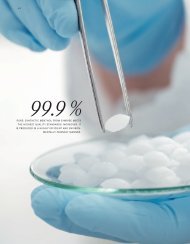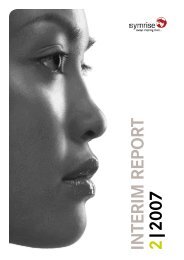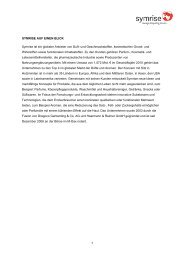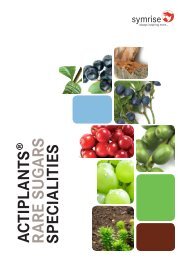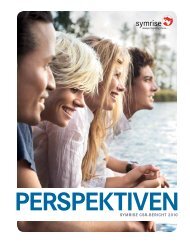THE NATURE OF OUR BUSINESS – STABLE GROWTH - Symrise
THE NATURE OF OUR BUSINESS – STABLE GROWTH - Symrise
THE NATURE OF OUR BUSINESS – STABLE GROWTH - Symrise
Create successful ePaper yourself
Turn your PDF publications into a flip-book with our unique Google optimized e-Paper software.
company is lost. The changed provisions are to be applied at the<br />
latest for fiscal years commencing on or after July 1, 2009. It is not<br />
expected that the revised IAS 27 will have an impact on future financial<br />
statements of the <strong>Symrise</strong> Group.<br />
IAS 32 (“Puttable Financial Instruments and Obligations Arising<br />
on Liquidation”) includes revised provisions to differentiate<br />
between equity and debt. The changed provisions are to be applied<br />
for the first time to fiscal years commencing on or after January<br />
1, 2009. It is not expected that the changed version of IAS 32<br />
will have any significant impact on the consolidated financial statements<br />
of <strong>Symrise</strong> AG.<br />
The supplementary amendments to IAS 39 (“Financial Instruments:<br />
Recognition and Measurement: Eligible Hedged<br />
Items”) explain, amongst other things, the conditions under which<br />
inflation risks can be hedged as hedged items within the context<br />
of hedging transactions as well as the possibility of using options<br />
as hedging instruments to hedge unilateral risks. The interpretation<br />
is to be applied to fiscal years commencing on or after January 1,<br />
2009. Earlier application is recommended. Impacts on the <strong>Symrise</strong><br />
Group are currently being assessed.<br />
IFRIC 13 (“Customer Loyalty Programmes”) governs the accounting<br />
for companies that offer loyalty programs to their customers<br />
or that participate in such programs. The type of loyalty<br />
programs covered are those under the terms of which loyalty<br />
award credits for free or discounted goods or services are granted<br />
to customers, who receive these when they purchase other goods<br />
or services. The interpretation should be applied for the first time<br />
to fiscal years commencing on or after July 1, 2009. It is not expected<br />
that IFRIC 13 will have any significant impact the consolidated<br />
financial statements of <strong>Symrise</strong> AG.<br />
IFRIC 15 (“Agreements for the Construction of Real Estate”)<br />
addresses the standardization of accounting practices used by<br />
companies that undertake the development of real estate and in<br />
this capacity sell units - such as, for example, apartments or<br />
houses – “off plan,” i.e. before these are completed. This interpretation<br />
should be applied to fiscal years that commence on or<br />
after January 1, 2009. Earlier adoption is recommended. It is not<br />
expected that IFRIC 15 will have any impact on the consolidated<br />
financial statements of <strong>Symrise</strong> AG.<br />
IFRIC 17 (“Distributions of Non-cash Assets to Owners”) addresses<br />
issues as to how a company should measure assets used<br />
to make distributions other than cash that are used to pay dividends<br />
to shareholders. IFRIC 17 comes into effect for financial<br />
Annual Report 2008 <strong>Symrise</strong> AG 101<br />
years commencing on or after July 1, 2009. Earlier application is<br />
permissible. It is not expected that IFRIC 17 will have any impact<br />
on the consolidated financial statements of <strong>Symrise</strong> AG.<br />
2.3.Key Judgments and Estimates<br />
The most important future assumptions and other significant<br />
sources of uncertainty in estimates at the balance sheet date,<br />
which may result in a significant risk that the carrying amounts of<br />
assets and liabilities will require adjustment within the next fiscal<br />
year, are discussed below.<br />
Impairment of intangible assets with indefinite useful lives<br />
At least once a year, the Group reviews whether intangible assets<br />
with indefinite useful lives (mainly goodwill and certain recipes)<br />
are impaired. This requires an estimate of the recoverable amounts<br />
of the cash-generating units to which these assets are allocated.<br />
In order to estimate the recoverable amount, the Group has to estimate<br />
the expected future cash flows deriving from the cash-generating<br />
unit and also to choose a suitable discount rate in order to<br />
calculate the present value of these cash flows. As at December<br />
31, 2008, the carrying amount of intangible assets with indefinite<br />
useful lives was € 521.2 million (2007: € 486.2 million). More details<br />
are provided in notes 8.10 and 8.11.<br />
Recoverability of deferred tax assets<br />
The Group makes an annual assessment as to whether tax loss<br />
carry-forwards can be used to offset against future taxable profits<br />
over a foreseeable period. This requires that the Group makes<br />
an estimate of the taxable income for each Group company. As at<br />
December 31, 2008, the carrying amount of the deferred tax assets<br />
was € 44.6 million (2007: € 58.7 million). More details are<br />
provided in note 8.7.<br />
Pensions and other post-employment benefits<br />
The expenses deriving from defined benefit pension plans and the<br />
Group’s obligation to provide additional post-employment healthcare<br />
benefits are determined on the basis of actuarial computations.<br />
The actuarial valuation is made on the basis of assumptions<br />
pertaining to discount rates, anticipated income from plan assets,<br />
future wage and salary increases, mortality rates and future pension<br />
increases. Due to the long-term nature of such plans, these<br />
estimates are subject to great uncertainty. As at December 31,<br />
2008, the provisions for retirement benefit and similar obligations<br />
amounted to € 191.9 million (2007: € 186.3 million). Further details<br />
are provided in note 8.19.<br />
Notes



